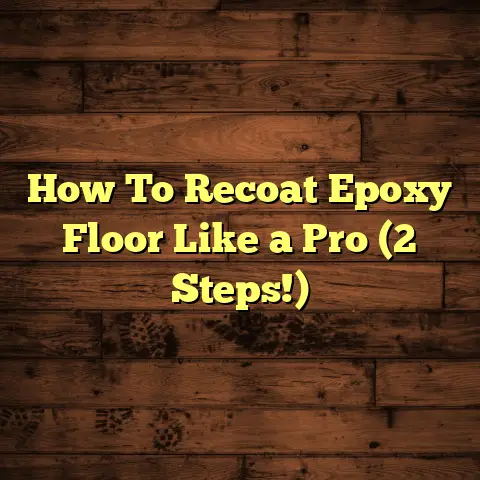How To Level Floor For LVP? (3 Mistakes To Avoid!)
Imagine this: You walk into a room.
A perfectly leveled floor greets you.
Each step is solid, secure.
No wobbles, no unsettling dips.
The sound? A soft, unyielding echo.
The look? Seamless Luxury Vinyl Plank (LVP).
It transforms the whole space!
Warmth radiates from the surface.
Now picture the opposite.
An uneven floor.
That jarring sensation underfoot.
Creaks and shifts with every move.
Planks that don’t quite fit.
It’s a visual nightmare, right?
That’s why leveling your floor before LVP is so crucial.
Let’s dive into how to get it right, and avoid some common pitfalls.
Understanding the Importance
of a Level Floor for LVP
Why bother leveling at all?
Because uneven floors can wreak havoc on your beautiful LVP!
Think of it like this:
LVP is designed to be supported evenly.
If it’s not, you’ll get:
-
Increased Wear and Tear: High spots take all the abuse.
-
Potential Damage: Planks can crack or separate.
-
Unstable Flooring: That annoying “give” underfoot.
A level floor is the foundation for a long-lasting, gorgeous LVP install.
It ensures:
-
Comfort: A solid, stable feel.
-
Aesthetics: Seamless, professional look.
-
Longevity: Your LVP will last for years.
“According to the Resilient Floor Covering Institute (RFCI), subfloor flatness is a critical factor affecting the performance and appearance of resilient flooring such as LVP.”
I’ve seen firsthand what happens when this is ignored.
A client rushed the job, skipped leveling, and within a year, their brand-new LVP was popping up at the seams!
Cost them way more to fix than if they’d leveled properly in the first place.
Assessing Your Current Floor Condition
Okay, so how do you know if your floor needs leveling?
Let’s walk through the assessment process.
Step 1: Gather Your Tools
You’ll need:
-
A long level (at least 6 feet): The longer, the better.
-
A straight edge (like a long ruler): For smaller areas.
-
A measuring tape: To note any significant dips.
-
A pencil: To mark problem areas.
Step 2: The Level Test
Place the level on the floor in various directions – lengthwise, widthwise, and diagonally.
Look for gaps between the level and the floor.
If you see gaps greater than 3/16 of an inch over a 6-foot span, you’ve got an uneven floor.
“Most LVP manufacturers recommend a subfloor that is flat to within 3/16 inch over a 10-foot span,” says the North American Laminate Flooring Association (NALFA).
Step 3: The Straight Edge Test
For smaller areas or to pinpoint specific problems, use the straight edge.
Same process: look for gaps.
Step 4: Look and Listen
-
Water Pooling: If water consistently pools in one area, that’s a low spot.
-
Gaps in Existing Flooring: Gaps between tiles or planks are a sign of an uneven subfloor.
-
Creaking Noises: Creaks often indicate movement caused by an uneven surface.
I remember one inspection where the homeowner swore their floor was level.
But as I walked around, I heard a distinct creak in one corner.
Turns out, there was a significant dip hidden under their old carpet!
Saved them a huge headache by catching it early.
Preparing for Floor Leveling
Alright, you’ve assessed your floor and it needs some love.
Let’s get prepped!
Materials You’ll Need:
-
Self-Leveling Compound: The star of the show.
-
Primer: Helps the compound adhere.
-
Mixing Bucket: Large enough for the job.
-
Drill with Mixing Paddle: Essential for smooth mixing.
-
Trowel: For spreading the compound.
-
Spiked Roller (optional): Helps release air bubbles.
Safety First!
-
Wear safety glasses: Protect your eyes from splashes.
-
Wear gloves: The compound can irritate skin.
-
Wear a dust mask: Especially when mixing dry materials.
Prep Steps:
-
Clear the Area: Remove all furniture, appliances, and existing flooring.
-
Clean the Floor: Sweep, vacuum, and scrub to remove dirt, debris, and adhesive residue.
-
Repair Minor Damage: Fill any cracks or holes with patching compound.
-
Apply Primer: Follow the manufacturer’s instructions. This is crucial for adhesion.
I can’t stress enough the importance of proper prep.
Once, a client skipped the priming step, and the self-leveling compound completely failed to bond.
A costly and time-consuming mistake!
The Floor Leveling Process
Here’s the nitty-gritty:
leveling your floor.
Step 1: Mixing the Compound
-
Read the Instructions: Every compound is different. Follow the manufacturer’s instructions exactly.
Add Water Gradually: Use the correct amount of water.
Too much or too little will ruin the mix.Mix Thoroughly: Use the drill and mixing paddle.
Mix until you have a smooth, lump-free consistency.
Step 2: Pouring and Spreading
-
Pour Carefully: Start at the deepest part of the floor and pour evenly.
-
Spread with a Trowel: Use the trowel to guide the compound and ensure it covers the entire area.
-
Use a Spiked Roller (Optional): Roll over the surface to release any trapped air bubbles.
Step 3: Drying Time
-
Be Patient: Allow the compound to dry completely before proceeding.
-
Check the Instructions: Drying times vary, but it’s usually 24-48 hours.
I always recommend erring on the side of caution when it comes to drying time.
Too much moisture can cause problems with your LVP installation.
Troubleshooting Tips:
-
Compound Drying Too Fast: Work in smaller sections or use a compound with a longer working time.
-
Air Bubbles: Use a spiked roller or gently tap the surface with a trowel.
-
Uneven Spread: Use a gauge rake to ensure an even layer of compound.
The Three Mistakes to Avoid
When Leveling Floors for LVP
Now, let’s talk about the big no-nos.
These are the mistakes I see homeowners make all the time.
Mistake 1: Skipping the Assessment Stage
The Danger:
Walking in blind.
You might think your floor is “good enough,” but you could be dead wrong.
Consequences:
-
Uneven LVP: Planks won’t lay flat.
-
Premature Wear: High spots will wear out faster.
-
Costly Repairs: You’ll have to redo the job.
Real-Life Example:
I had a client who thought their concrete slab was perfectly flat.
They skipped the assessment, installed the LVP, and within months, the seams started to separate.
Turns out, there was a subtle dip right in the middle of the room.
Had to rip everything up and start over!
Mistake 2: Using the Wrong Materials
The Danger:
Cutting corners on quality.
Not all self-leveling compounds are created equal.
Consequences:
-
Poor Adhesion: The compound won’t stick properly.
-
Cracking: The compound can crack or crumble.
-
Inconsistent Results: You won’t get a perfectly level surface.
How to Choose the Right Products:
-
Consider Your Subfloor: Different compounds are designed for different surfaces (concrete, wood, etc.).
-
Read Reviews: See what other users have to say.
-
Consult a Professional: Ask for recommendations.
I always recommend using a reputable brand and choosing a compound specifically designed for LVP installation.
It’s worth the extra investment!
Mistake 3: Neglecting Drying Times
The Danger:
Impatience.
You’re excited to get your new floor installed, but rushing the drying process is a recipe for disaster.
Consequences:
-
Moisture Problems: Trapped moisture can damage the LVP and lead to mold growth.
-
Adhesive Failure: The LVP adhesive won’t bond properly.
-
Warping: The LVP can warp or buckle.
Anecdote:
I once worked on a project where the homeowner insisted on installing the LVP just 12 hours after pouring the self-leveling compound.
I warned them against it, but they wouldn’t listen.
A few weeks later, they called me back in a panic.
The LVP was bubbling up and the adhesive had failed.
Had to rip everything up and let the compound dry properly before reinstalling.
Patience is key!
Conclusion
Leveling your floor is the foundation for a successful LVP installation.
Remember that feeling of walking onto a perfectly leveled floor?
Solid, secure, beautiful.
That’s what you’re aiming for!
By taking your time, avoiding these common mistakes, and following the steps outlined in this article, you can achieve a flawless, long-lasting LVP floor that you’ll love for years to come.
Good luck with your project!





